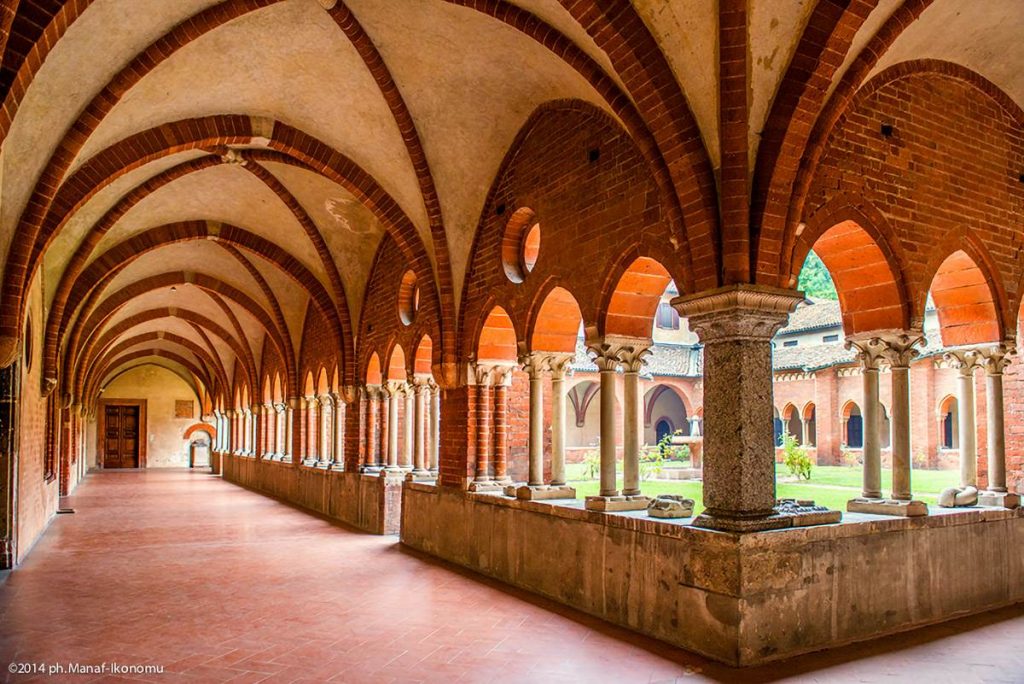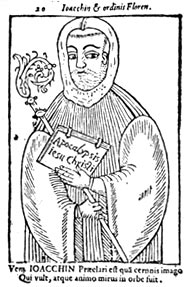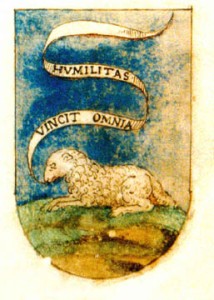A holy woman and a soldier connect the poet Rainer Maria Rilke with the Popess of one of the earliest extant tarot decks, an odd and enigmatic artwork from late medieval Northern Italy. This is Part 2 of a three-part post on Rainer Maria Rilke and The Popess tarot card. PART 1 | PART 2 | PART 3 | SOURCES | Brief Intro to the Tarot
The Holy Woman Guglielma
The charges of heresy against the Visconti mentioned as evidence the family’s association with a religious cult centered on a holy woman named Guglielma.
Guglielma’s origins are obscure. One fairly well-founded legend of her life claims that she was born in 1210 as a Bohemian princess. She may have married someone in the Piedmont. In any case, from around 1260 to her death in 1281, she lived in Chiaravalle, a village about 8 kilometers outside the city center of Milan.

Aristocratic origins or not, Guglielma adopted the life of a pinzochera, a lay order of devout women associated with monastic orders. The pinzochere often wore monastic garb and sometimes lived within monastic compounds, but since they did not take full ordination they could work “in the world,” a great help to cloistered orders.
Guglielma’s intense charisma and genuine sanctity drew a group of deeply devoted disciples. Such an assembly was not unusual or proscribed; local veneration of holy people cultivates still the seedbed of saints. While the Roman church held legal and ecclesiastical sway, many such cults flourished throughout Europe, with and without official sanction. As long as they did not stray too obviously from the dogma of the Church, or grow too influential, or get sucked into rivalries between monastic orders, the authorities tolerated them.
Guglielma’s fame seemed to follow a safe trajectory. At her death in 1281, she was entombed with reverence in the Cistercian abbey of Chiaravalle. The monks of the abbey and her lay followers considered her a saint, though she was never beatified.
Far from it.
Maifreda [Manfreda] da Paravano
Guglielma consistently labeled herself an ordinary, sinful woman. A small, ardent group of her followers, who formed what scholar Barbara Newman aptly calls “a cult within a cult,” believed her to be much more.
The Guglielmites, whether through Guglielma herself or on their own initiative, absorbed into their creed the teachings of Joachim of Fiore (circa 1135–1202), an influential theologian and founder of an abbey in Fiore, Calabria. During his life, Joachim was held in high esteem and apparently did not encounter hostility from the Church. His fame endured; Dante placed Joachim in Paradise in his 1320 epic. Others, most notably Thomas Aquinas, denounced Joachim’s teachings.

Joachim taught that the world’s progress falls into three ages, corresponding to the Trinity as understood by the Catholic Church. The Age of the Father, or the Old Testament, was characterized by patriarchal authority. The Age of the Son, or the New Testament, demonstrated salvation through the divine potential of the human being. The Guglielmites seized particularly on the impending age, that of the Holy Spirit. In that age, all people, regardless of their previous beliefs, would be united in love. The letter of the law—including that of the scriptures and the Church—would no longer be needed. The beginning of the end, Joachim predicted, would occur around 1260. That happened to be around the time Guglielma arrived in Milan.
The Guglielmites, possibly embracing not only Joachim’s works but other works incorrectly attributed to him, decided to establish a church in which women held the highest ranks. They taught that in the coming Age of the Holy Spirit, even heretics, Jews, so-called heathens (people of other creeds), and atheists would be saved without deliberate conversion. Most audacious of all, they worshipped Guglielma as the incarnation of the Holy Spirit sent to inaugurate Joachim’s new age.
On Guglielma’s death, the “cult within a cult” elected as her successor a cousin of Matteo Visconti, Maifreda da Pirovano, of the Humiliati lay order, founded in Lombardy in the 12th century. In the early 13th century, the Vatican authorized the Humiliati “by a singular concession, to meet on Sunday to listen to the words of a brother ‘of proved faith and prudent piety,’ on condition that the hearers should not discuss among themselves either the articles of faith or the sacraments of the church.” (Alphandéry)

This was a rule made to be broken, and it was, by the Guglielmites. Not only did they discuss and embellish their “articles of faith” among themselves, “several devotees honored Sister Maifreda as the Holy Spirit’s earthly vicar by kissing her hands and feet and addressing her as ‘Lord Vicar’ or ‘Lady by the grace of God.’” (Newman, 2005). They even made for her priest’s vestments, so that she might celebrate mass.
Things were getting way out of hand, as far as the Papacy was concerned. Equality of class and gender, free salvation, females enjoying male prerogatives, and even the female body clad in priest’s robes?
Nope.
The simmering enmity between the Vatican and the Visconti, feuds between different monastic orders, and the mutual antipathy of the Milanese and the Inquisition brought the situation to a boil.
In 1300—the very year in which the New Age of the Holy Spirit was to have dawned—the Inquisition condemned Maifreda and several of her followers to be burned to death as heretics. Guglielma’s remains were disinterred and desecrated, and her tomb was destroyed, along with writings by her disciples and any images of her that could be found.
Thus, the Inquisition methodically destroyed, so they thought, Guglielma’s legacy. Paradoxically, the Inquisition’s own records preserved much of what we know today about the cult. A copy of the Inquisition records concerning Guglielma turned up in Pavia, the seat of the Visconti, in the 17th century. Matteo Visconti had apparently had the records copied, with the most incriminating testimony expunged, leaving enough information about the Guglielmites to give the impression that, as Newman says, “the Visconti continued to cherish the memory of St. Guglielma and Sister Maifreda, and were determined to preserve a record of their religious movement in private hands where the knowledge could do no further harm.”
Guglielma’s legacy survived not only in Inquisition records, however. An oral tradition was evidently passed down, for around 1425, a Franciscan friar in Ferrara wrote a hagiography of Guglielma. The friar’s work reads more like a religious dime novel than a well-researched biography, yet it proves that Guglielma’s worship lived in Ferrara over a century after her death in Chiaravalle.
Ferrara is over 200 kilometers from Chiaravalle. Newman posits that Ferrara might have endured as a center of the Guglielmites because Matteo’s son Galeazzo went to ground there when a rival family controlled Milan from 1302 to 1310. (Ferrara, by the way, like Milan also originated some of the earliest extant hand-painted tarot decks.) The Visconti having suppressed the Inquisition’s investigation concerning their family, Guglielma’s posthumous followers in Ferrara may not have known the fate of the first-generation disciples in Chiaravalle.
Having survived the Inquisition’s efforts to wipe out her legacy, Guglielma’s next station would be even further from Milan. In Brunate, a remote mountain village above the town of Como, the confluence of two powerful women secured her fame. Part 3: Two powerful women
RENAISSANCE ITALY: GLORY, BEAUTY, GREED, WAR.
A POWERFUL HOLY WOMAN. THE INQUISITION….
A novel based on the true story of the Popess card of the tarot.
BUY: Signed by author, free shipping in US
BUY: bookshop.org | Amazon US | Amazon CA | B&N | indiebound
“Enchanting & richly historical, heart-wrenching & intoxicating.” —Stuart R. Kaplan, author Pamela Colman Smith.
“A storytelling treasure. The sights, smells, feel of Renaissance Italy seep from every pore of the story.” —Ron Andre, A Matter of Fancy

Pingback:Rainer Maria Rilke and the Tarot Popess | Part 3 | JEAN HUETS
Pingback:Rainer Maria Rilke and the Tarot Popess | Part 1 | JEAN HUETS
Pingback:Rainer Maria Rilke and the Tarot Popess sources | JEAN HUETS